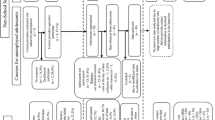Abstract
Objective
Prevalence of behavioural and emotional problems in primary school children was examined 4 years after a baseline survey at preschool age. The scope of symptoms was investigated. Due to anonymity of data only group differences between the two measurements were reported.
Method
A representative sample of 1,481 children in fourth year primary school was assessed with the Child Behaviour Checklist (CBCL). In addition to the CBCL broadband groups of internalizing (INT) and externalizing symptoms (EXT) a third group of combined internalizing and externalizing symptoms (COM) was defined.
Results
The 6 month prevalence of child mental health problems at second wave was 18%—a significant increase on the previous baseline rate of 12.4%. Of those 18% of children with child mental health problems 27.3% had exclusively internalizing, 6.0% externalizing symptoms and 52.4% had combined symptoms of INT and EXT.
Conclusion
The increasing prevalence was associated with an increase of symptoms of the broadband groups INT and COM but not EXT. The results also highlight an age and gender specific vulnerability of boys, both at preschool and primary school.

Similar content being viewed by others
References
Achenbach TM (1991) Manual for the child behavior checklist/4–18 and 1991 profile. University of Vermont Department of Psychiatry, Burlington, VT
Achenbach TM, Howell CT, Mcconoughy SH, Stanger C (1995) Six-year predictors of problems in a national sample of children and youth, II: signs of disturbance. J Am Acad Child Adolesc Psychiatry 34:488–498
Arbeitsgruppe Deutsche Child Behavior Checklist (1998) German Version of the Child Behavior Checklist, Arbeitsgruppe Kinder- Jugend- und Familiendiagnostik, Cologne
Blumberg SH, Izard C (1985) Affective and cognitive characteristics of depression in 10- and 11-year-old children. J Pers Soc Psychol 49:194–202
Bongers I, Koot H, Van Der Ende J, Verhulst FC (2003) The normative development of child and adolescent problem behavior. J Abnorm Psychol 112:179–192
Campbell SB (1995) Behavior problems in preschool children: a review of recent research. J Child Psychol Psychiatry 36:113–149
Colder CR, Stice E (1998) A longitudinal study of the interactive effect of impulsivity and anger on adolescent problem behaviour. J Youth Adolesc 27:255–274
Costello EJ, Mustillo S, Erkanli A, Keeler G, Angold A (2003) Prevalence and development of psychiatric disorders in childhood and adolescence. Arch Gen Psychiatry 60:837–844
Doepfner M, Plueck J, Berner W, et al. (1997) Psychische Auffaelligkeiten von Kindern und Jugendlichen in Deutschland - Ergebnisse einer repraesentativen Studie: Methodik, Alters-, Geschlechts- und Beurteilereffekte. Z Kinder Jugendpsychiatr 25:218–233
Eisenberg N, Cumberland A, Spinrad TL, et al. (2001) The relations of regulation and emotionality to children’s externalizing and internalizing problem behavior. Child Dev 72:1112–1134
Fombonne E (1994) The Chartres Study, I: prevalence of psychiatric disorders among French school-aged children. Br J Psychiatry 164:69–79
Ford T, Goodman R, Meltzer H (2003) The British child and adolescent mental health survey 1999: the prevalence of DSM-IV disorders. J Am Acad Child Adolesc Psychiatry 42:1203–1211
Furniss T, Beyer T, Guggenmos J (2006) Prevalence of behavioural and emotional problems among six-years-old preschool children: baseline results of a prospective longitudinal study. Soc Psychiatry Psychiatr Epidemiol 41:394–399
Garland AF, Hough RI, Mccabe KM, Yeh M, Wood PA, Aarons GA (2001) Prevalence of psychiatric disorders in youths across five sectors of care. J Am Acad Child Adolesc Psychiatry 40:409–418
Haffner J, Esther C, Münch H, et al. (2002) Verhaltensauffaelligkeiten im Einschulungsalter aus elterlicher Perspektive: Ergebnisse zu Praevalenz und Risikofaktoren in einer epidemiologischen Studie. Praxis Kinderpsychol Kinderpsych 51:675–696
Keiley MK, Bates JE, Dodge KA, Pettit GS (2000) Cross-domain growth analysis: externalizing and internalizing behaviors during 8 years of childhood. J Abnorm Child Psychol 28:61–179
Keltner D, Moffitt TE, Stouthamer-Loeber M (1995) Facial expression of emotion and psychopathology in adolescent boys. J Abnorm Psychol 104:644–652
Kim-Cohen J, Caspi A, Moffitt TE, Harrington HI, Milne BJ, Poulton R (2003) Prior juvenile diagnoses in adults with mental disorder: developmental follow-back of a prospective-longitudinal cohort. Arch Gen Psychiatry 60:709–717
Kroes M, Kalff AC, Steyaert J, et al. (2002) A longitudinal community study: do psychosocial risk factors and child behavior checklist scores at 5 years of age predict psychiatric diagnoses at a later age? J Am Acad Child Adolesc Psychiatry 41:955–963
Lavigne JV, Arend RP, Rosenbaum DP, Binns HJM, Christoffel KKM, Gibbons RDP (1998) Psychiatric disorders with onset in the preschool years: I. Stability of diagnoses. J Am Acad Child Adolesc Psychiatry 37:1246–1254
Lavigne JV, Gibbons RD, Christoffel KK, et al. (1996) Prevalence rates and correlates of psychiatric disorders among preschool children. J Am Acad Child Adolesc Psychiatry 35:204–214
Puura K, Almqvist F, Tamminen T, et al. (1998) Psychiatric disturbances among prepubertal children in Southern Finland. Soc Psychiatry Psychiatr Epidemiol 33:310–318
Roberts RE, Attkisson CC, Rosenblatt A (1998) Prevalence of psychopathology among children and adolescents. Am J Psychiatry 155:715–725
Verhulst FC, Van der Ende J (1992) Six-year developmental course of internalizing and externalizing problem behaviors. J Am Acad Adolesc Psychiatry 31:941–950
Verhulst FC, Van der Ende J (1997) Factors associated with child mental health service use in the community. J Am Acad Adolesc Psychiatry 36:901–909
Zahn-Waxler C, Klimes-Dougan B, Slattery MJ (2000) Internalizing problems of childhood and adolescence: prospects, pitfalls, and progress in understanding the development of anxiety and depression. Dev Psychopathol 12:443–466
Author information
Authors and Affiliations
Corresponding author
Rights and permissions
About this article
Cite this article
Beyer, T., Furniss, T. Child psychiatric symptoms in primary school. Soc Psychiat Epidemiol 42, 753–758 (2007). https://doi.org/10.1007/s00127-007-0224-x
Accepted:
Published:
Issue Date:
DOI: https://doi.org/10.1007/s00127-007-0224-x



